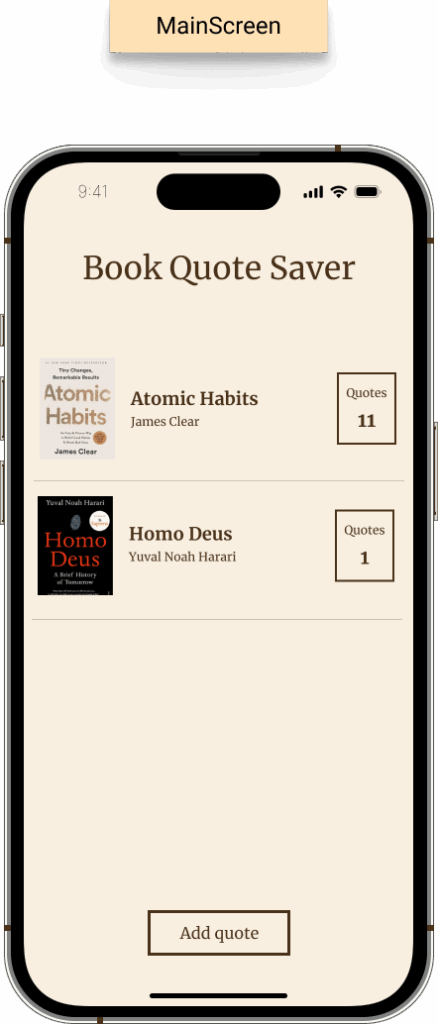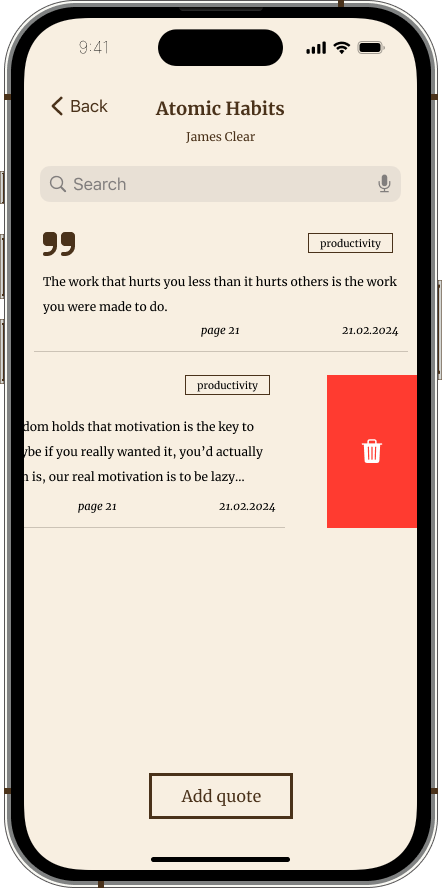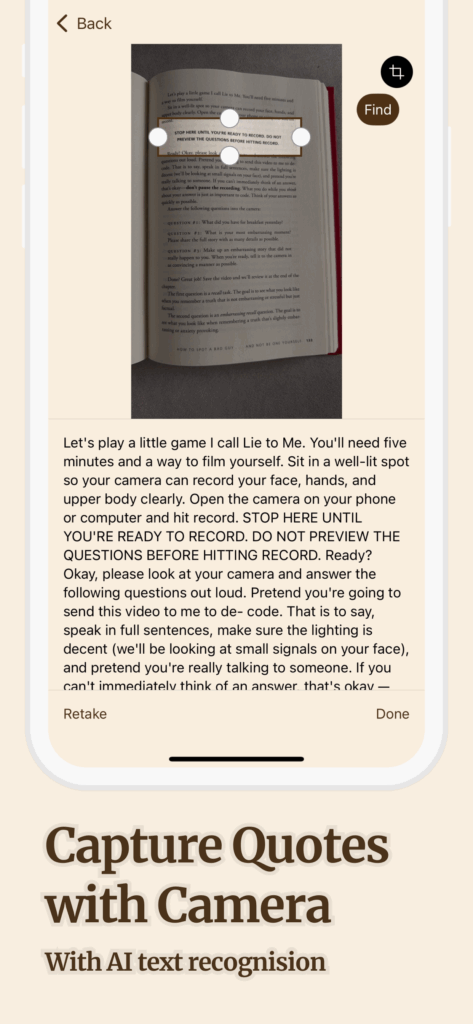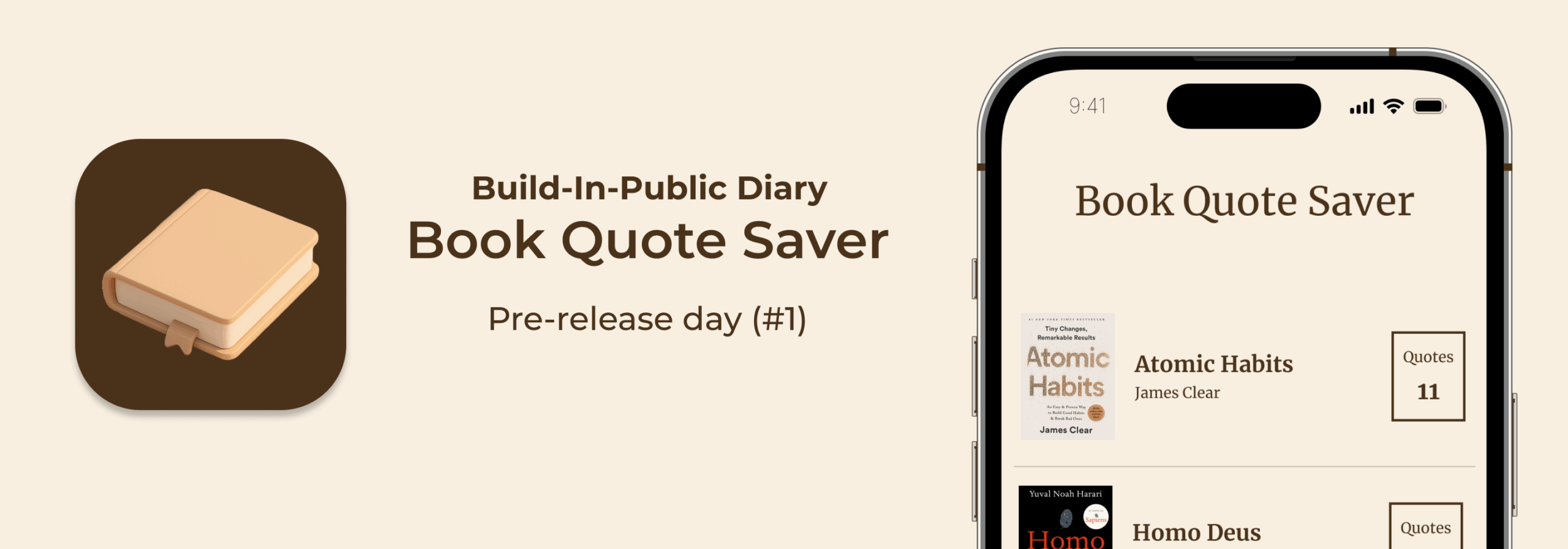How a year of weekly mentoring sessions turned a book-oriented idea into an iOS app we can’t wait to ship.
TL;DR
I’d been nursing a “save every book quote worth keeping” idea for ages. Last year I laid out all the screens and tasks, then handed the code baton to my mentee Mateusz. A year of steady sessions later, we’ve got a polished Book Quote Saver app (and a partnership we trust for whatever we build next). Beta seats are open; want to try it first?
1 · The Spark (Day 0)
Mid-May, Warsaw. Subway line M2 rumbling beneath the Vistula. I’m wedged between seats, reading a copy of Outlive. My fifth margin note about fasting labs and omega-3 ratios is already smudging, and I know the page flag will fall out by next week. These lines are gold, yet they’ll disappear the moment I close the cover. I need a place where the important bits don’t vanish.
This situation sparked an idea in my head: build a place where good lines don’t get lost, and do it without burning my evenings on yet another solo-coding marathon.
How to avoid a burnout?
I already write software 9-to-5, so piling more code on top felt like asking for burnout. What I did want, though, was a way to teach, practice real-world product leadership, and ship faster than one person ever could. That’s when the mentoring plan clicked. If I could guide a junior developer through a full project, we’d both win: I’d sharpen my skills as a leader and product manager, and they’d get a free, hands-on apprenticeship.
Enter Mateusz. He took the code reins while I handled product, design, and roadmap. Week by week we reviewed pull requests, killed scope creep, and kept the vision tight. The result? Mateusz gains a solid portfolio and daily feedback; I gain leverage and a working app without midnight coding sprees. Everybody earns, and the Quote Saver moves from subway-seat idea to something you can soon download.
2 · Mentoring as a leverage
Every Sunday evening Mateusz and I jump on a short video call. It always follows the same three-step rhythm:
- Status check – he walks me through what’s done.
- Code walk-through – I’ve already pulled his branch, so we screen-share, spot edge-cases, and mark quick fixes. Most of the learning happens right here, in the back-and-forth.
- Next tasks – we open our board on Monday.com (Jira-style columns) and drag the next cards into “In Progress.”
Between calls, it’s mostly async. Mateusz codes; I review every pull request, add threaded comments, and suggest refactors or stretch challenges. We’re deliberately running this like a big-company sprint: monday.com board for tickets, unit tests guarding each feature, and tidy refactoring loops. The app itself could be hacked together in a couple of weeks, but the mission is to mirror a real-world workflow, so Mateusz gets genuine “team dev” reps and I hone my leadership game, all without burning out after my 9-to-5.
3 · 12-Month Timeline at a Glance
It started from the Initial Commit message on Jul 3, 2024.

What was achieved from that day?

Right after that first commit, we spent more time setting the rules than writing code.
We had to agree on everything:
Architecture – classic MVVM so views stay dumb and the logic sits in View Models.
Git flow – feature branches, pull-request reviews every Monday.
SwiftUI building blocks – first step towards Design System.
Localization – Creating a utility to manage translations easily.
What was next?

One month later the skeleton had some muscle: a working Main Screen mock.
Getting there forced a round of deeper plumbing:
Navigation – wired up a navigation stack so every screen change lives in one place, is easy to manage, and testable.
Dependency injection – services for Core Data, navigation, and User Defaults now arrive through protocols and are injected right into View Models.
Modularisation – split some of the layers into their own SPM packages.
By mid-September, we finally flipped to feature mode: add and edit quote flows went in, backed by Core Data. The app felt less like a demo and more like something you’d actually use.
Winter break

Dec – Jan
Mateusz had to step back for personal reasons, so the project went into “maintenance mode.” No drama, just real-life beats side-project velocity.
Feb – Mar
Back in action, we zeroed in on all CRUD paths – create, read, update, delete, and wrapped the whole user stories.
Recent changes

April – May · Polish & “Wow” Features
Camera capture – the most important one. We plugged in Apple’s Vision framework so you can point your phone at a page, tap once, and watch the quote pop into the editor—OCR and all.
Paywall polish – built a friendly upgrade screen (promo for early users!), we used RevenueCat for easy implementation.
By the end of May the app felt complete: bulletproof CRUD, a smooth paywall, and our signature “snap-a-quote” magic. Time to invite beta testers!
4 · The Mission (Why We Still Care After 365 Days)
I’m still underlining sentences in books, and Mateusz is still sending pull requests every week. That alone says the work is worth it.
- The problem is real. I need a dependable place for the lines that reshape my thinking. Each new build gets us closer.
- Mateusz is growing quickly. A year ago, he was still googling basic Swift patterns; today, he’s landed his first full-time role as an iOS developer. Seeing that progress is deeply satisfying.
- Our Sunday calls keep us on track. An hour of status, code review, and next-step planning maintains steady momentum.
Release day is next. I’m ready for the moment when the first outside user saves a quote and sends feedback. That will show us what to refine and what to build after this
5 · Call for Early Explorers
Beta is opening soon. We’re hunting for people who:
- Read compulsively (books, articles, cereal boxes 😉).
- Love giving blunt, constructive feedback.
- Would enjoy being the first users and getting closer to us.
Thank you for reading
Made with ☕ & an urge for creativity. Follow along on X.com/bartolomeo_dev
